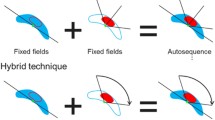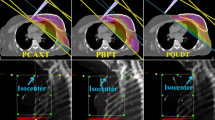Purpose:
Using three-dimensional conformal radiation therapy (3D-CRT) and multisegmented conformal radiation therapy (MS-CRT) for breast cancer treatment, the dose coverage of the planning target volume (PTV) and the radiation burden on the organs at risk (OARs) were evaluated.
Material and Methods:
3D-CRT and MS-CRT were planned for 436 unilateral breasts (217 left). All patients were treated with MS-CRT between 2005 and 2007. For PTV delineation and beam orientation, supportive structures were applied. The mean PTV was 1,130 cm3 (in ten patients > 2,200 cm3). Three-dimensional planning with weight-optimized medial and lateral open fields at a total dose of 50.4/1.8 Gy was followed by multisegmented planning with a reasonably high-dose-level dose cloud to define the medial subfield, and renewed optimization. This was repeated for the lateral subfield with a final optimization. For PTV coverage evaluation, the ICRU 50 was considered: the PTV portions receiving 95–107%, < 95% and > 107% of the prescribed dose (PTVD95– 107%, PTV<D95% and PTV>D107%), and the PTV maximal dose (PTVDmax). To compare the OAR radiation burdens, the mean doses to the ipsi-/contralateral lung, contralateral breast, and whole heart were documented.
Results:
The multisegmented plans furnished significantly (p < 0.0001) better target coverage (PTVD95–107% 82.8% vs. 90.9%, PTV<D95% 11.4% vs. 8.8%, PTV>D107% 5.9% vs. 0.3% and PTVDmax 56.6 vs. 54.3 Gy). The mean OAR doses remained almost unchanged: ipsilateral lung 10.5 versus 10.4 Gy, contralateral lung 0.4 versus 0.4 Gy, contralateral breast 0.8 versus 0.8 Gy, and whole heart (for left-sided cancers) 4.8 versus 4.8 Gy. The subfields required a mean of 9.8 MU (monitor units), i.e., a mean total 7.6 MU increment. The planning took 10–20 min, and the delivery 5–10 min.
Conclusion:
MS-CRT is a good alternative to breast intensity-modulated radiation therapy (IMRT) and seems adequate for right-sided cancers, whereas left-sided cancers necessitate a longer follow-up of heart-related side effects before a final assessment.
Ziel:
Die Erfassung des Planungszielvolumens (PTV) und die Strahlenbelastung der Risikoorgane (OARs) bei dreidimensionaler konformaler Radiotherapie (3D-CRT) oder multisegmentaler konformaler Radiotherapie (MS-CRT) des Mammakarzinoms wurden ausgewertet.
Material und Methodik:
Dreidimensionale und multisegmentale konformale Bestrahlungspläne wurden für 436 unilaterale (217 linksseitige) Brüste erstellt. Zwischen 2005 und 2007 erhielten alle Patientinnen eine MS-CRT. Zur PTV-Konturierung und Feldausrichtung wurden Hilfsstrukturen angebracht. Das durchschnittliche PTV betrug 1 130 cm3 (bei zehn Patientinnen > 2 200 cm3). Im Anschluss an die dreidimensionale Planung mit optimal gewichteten medialen und lateralen Feldern bis zu einer Gesamtdosis 50,4/1,8 Gy erfolgte die multisegmentale Planung mit einer angemessen hohen Dosiswolke für das mediale Teilfeld und erneuter Optimierung. Dies wurde für das laterale Teilfeld wiederholt und abschließend optimiert. Bei der Beurteilung der PTV-Erfassung wurde der ICRU 50 berücksichtigt: die Anteile des PTV, die 95–107%, < 95% und > 107% der verordneten Dosis erhielten (PTVD95–107%, PTV<D95%, PTV>D107%), sowie das Dosismaximum (PTVDmax). Zum Vergleich der Dosisbelastung der OARs wurden die Durchschnittsdosen der ipsi-/kontralateralen Lungen, der kontralateralen Brust und des Herzen dokumentiert.
Ergebnisse:
Die multisegmentale Planung erbrachte eine signifikant (p < 0,0001) bessere PTV-Erfassung (PTVD95–107% 82,8% vs. 90,9%, PTV<D95% 11,4% vs. 8,8%, PTV>D107% 5,9% vs. 0,3% und PTVDmax 56,6 vs. 54,3 Gy). Die durchschnittlichen OAR-Dosen blieben nahezu unverändert: ipsilaterale Lunge 10,5 versus 10,4 Gy, kontralaterale Lunge 0,4 versus 0,4 Gy, und kontralaterale Brust 0,8 versus 0,8 Gy, Herz (bei linksseitigem Brustkrebs) 4,8 versus 4,8 Gy. Für die Teilfelder wurden durchschnittlich 9,8 MU (Monitoreinheiten) benötigt, d.h. eine Gesamterhöhung um im Mittel 7,6 MU. Die Planungsprozedur dauerte 10–20 min und die Bestrahlung 5–10 min.
Schlussfolgerung:
Die MS-CRT stellt eine gute Alternative zur intensitätsmodulierten Radiotherapie (IMRT) der Brust dar und scheint sich vor allem bei rechtsseitigem Brustkrebs anzubieten, während bei Befall der linken Mamma aufgrund der kardialen Nebenwirkungen vor einer abschließenden Bewertung eine längere Nachbeobachtung erforderlich ist.
Similar content being viewed by others
Author information
Authors and Affiliations
Corresponding author
Rights and permissions
About this article
Cite this article
Gulybán, Á., Kovács, P., Sebestyén, Z. et al. Multisegmented Tangential Breast Fields: a Rational Way to Treat Breast Cancer. Strahlenther Onkol 184, 262–269 (2008). https://doi.org/10.1007/s00066-008-1770-1
Received:
Accepted:
Issue Date:
DOI: https://doi.org/10.1007/s00066-008-1770-1




